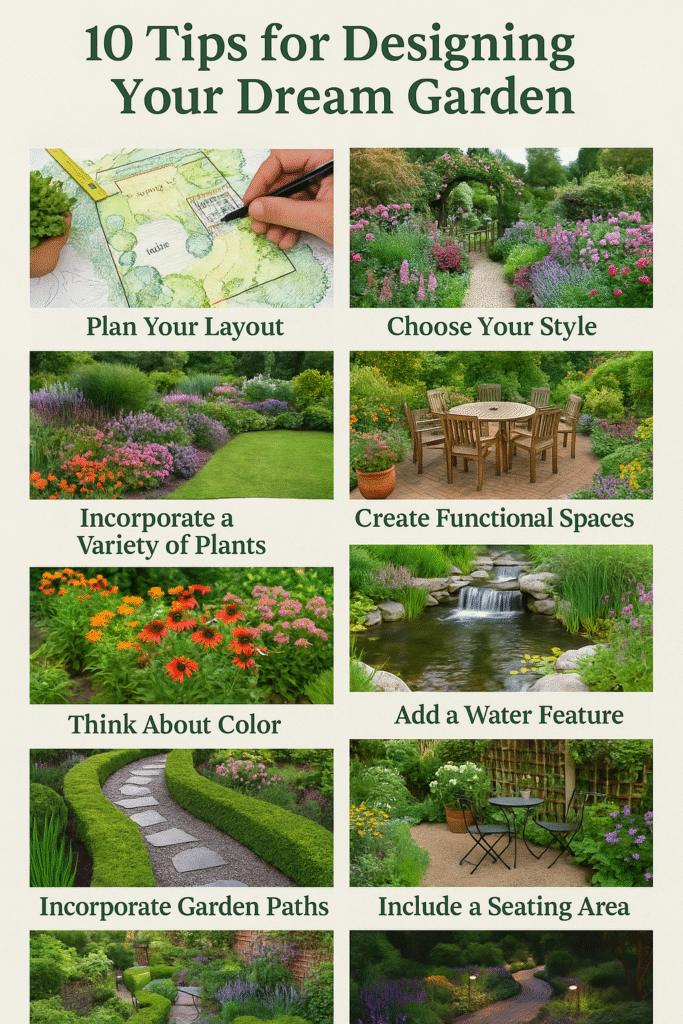10 Tips for Designing Your Dream Garden
The process of designing your ideal garden is an exciting one that combines planning, imagination, and a little bit of the magic of nature. Whether you have a little urban area or a large backyard, careful planning may turn any space into a private haven. These ten crucial pointers will help you create a garden that expresses your style and way of life.
1. Begin by creating a thorough garden layout plan.

Creating a thorough garden layout design is essential before you plant a single seed. This design ought to take into account:
Shade and Sunlight: Consider how sunlight flows through your area while placing plants.
- Soil Quality: To choose appropriate plant species, test the pH and fertility of the soil.
- Water Access: Ensure easy access to water sources for irrigation.
- Functional Zones: Allocate areas for relaxation, dining, play, and gardening.
Visualizing and improving your plan might be facilitated by using garden design software or speaking with a landscape architect.
2. Determine the Garden’s Style
Setting a consistent aesthetic for your landscape sets the tone for how it will seem. The following styles are popular:
Formal gardens are characterized by their symmetrical patterns and well-maintained hedges.
Cottage gardens are full of colors and densely planted flowers.
Hardscaping and a focus on simplicity and clean lines are common features of modern gardens.
Attracting and caring for local wildlife is the aim of wildlife gardens.
Your style choice will impact plant choices, materials, and overall design elements.
3. Incorporate Diverse Plantings for Year-Round Interest
A vibrant garden thrives on diversity. Consider integrating:
- Seasonal Plants: Select species that bloom in different seasons to maintain year-round colour.
- Evergreens: Provide structure and greenery throughout the year.
- Perennials and Annuals: Mix for continuous blooms and variety.
- Native Plants: Adapted to local conditions, they require less maintenance and support local ecosystems.
Grouping plants with similar water and sunlight needs simplifies care and enhances plant health.
4. Create Inviting Outdoor Seating Areas
Designing comfortable outdoor seating areas encourages relaxation and socialisation. Options include:
- Patios and Decks: Ideal for dining and entertaining.
- Garden Benches: Offer quiet spots for contemplation.
- Hammocks or Swing Chairs: Add a playful, relaxing element.
Position seating to take advantage of views, shade, and privacy, enhancing the garden’s usability.
5. Design Functional and Aesthetic Garden Paths
Well-planned garden path ideas contribute to both function and beauty. Consider:
- Materials: Gravel, stone, brick, or wood can complement your garden’s style.
- Layout: Curved paths create a sense of discovery, while straight paths offer formality.
- Integration: Paths should connect different garden zones seamlessly.
Incorporating lighting along paths enhances safety and ambiance during evening hours.
6. Introduce Water Features for Tranquility
Adding a water feature for garden spaces introduces soothing sounds and visual interest. Options include:
- Fountains: Provide a focal point and mask background noise.
- Ponds: Support aquatic plants and attract wildlife.
- Waterfalls or Streams: Add movement and a naturalistic feel.
Ensure water features are proportionate to your garden’s size and style for harmonious integration.
7. Utilise Vertical Gardening Techniques
Maximise space and add visual intrigue with vertical garden elements:
- Trellises and Arbors: Support climbing plants and define spaces.
- Living Walls: Create lush, green backdrops.
- Hanging Planters: Ideal for herbs or trailing flowers.
Vertical gardening is especially beneficial in small or urban gardens, adding greenery without occupying ground space.
8. Implement Strategic Garden Lighting
Effective garden lighting extends usability into the evening and highlights key features:
- Ambient Lighting: Soft illumination for general areas.
- Task Lighting: Focused lights for cooking or reading zones.
- Accent Lighting: Spotlights to showcase plants, sculptures, or water features.
Opt for energy-efficient options like LED or solar-powered lights to reduce environmental impact.
9. Incorporate Natural Shade Elements
Providing natural shade enhances comfort and plant diversity:
- Trees: Offer canopy cover and habitat for wildlife.
- Pergolas or Gazebos: Create sheltered seating areas.
- Shade-Tolerant Plants: Ferns, hostas, and impatiens thrive in lower light conditions.
Understanding your garden’s microclimates helps in selecting appropriate shade solutions.
10. Plan for Sustainability and Maintenance
A sustainable garden is both environmentally friendly and easier to maintain:
- Composting: Recycles organic waste into nutrient-rich soil.
- Rainwater Harvesting: Collects water for irrigation, reducing reliance on municipal sources.
- Mulching: Retains soil moisture and suppresses weeds.
- Low-Maintenance Plants: Choose hardy species suited to your local climate.
Regular maintenance schedules ensure your garden remains healthy and vibrant throughout the year.
Conclusion
Designing your dream garden is a rewarding endeavour that combines personal expression with thoughtful planning. By considering layout, style, plant diversity, functional spaces, and sustainability, you can create a garden that not only enhances your home’s aesthetic but also provides a sanctuary for relaxation and enjoyment. Embrace these tips to cultivate a space that reflects your vision and brings joy for years to come.
more information:
- Best Gardening Tools for Beginners

